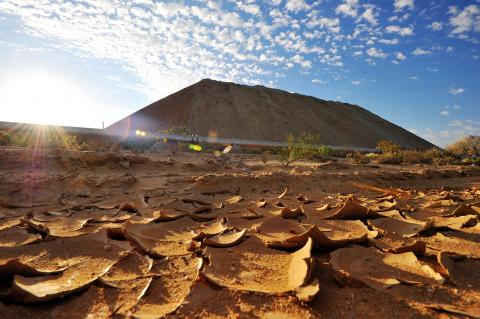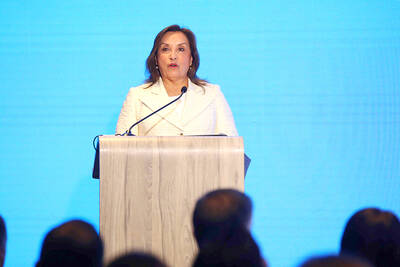The man slips the plastic pouch of gems into his mouth, an illicit haul from the sandy deposits scattered among the mountains of South Africa’s diamond coast.
“It’s my safe,” he explains, sliding the stash back along the inside of his cheek.
The group of diggers are waiting for the cover of darkness to make another raid on a disused mine, opposite their make-shift camp, where 10 miners died in an avalanche three months ago.

Photo: AFP
Illegal miners in South Africa are ready to risk death to chase a share of the mineral riches that shaped the continent’s biggest economy.
In sparsely populated Namaqualand, where the famed gem deposits run along the icy Atlantic Ocean to the Namibian border, diamond giant De Beers was once the top employer, providing 3,000 jobs and building two towns with recreation halls, a golf course and schools, to house its staff.
However, its mines were halted in 2008 and the company’s Namaqualand operations are in the final stages of a 225 million rand (US$27 million) sell-off after years of retrenchments.
The slowdown has emptied out the private mining towns, but has lured growing numbers of diggers from the area’s other small settlements into the abandoned fields.
“I can say that more than 60 percent of the active workforce are involved in the informal diamond trade,” said Andy Pienaar, of the social outreach office in Komaggas, one of the few small villages in the mining area.
“There was sort of a blessing from the community that ‘people, you may go’” dig, he added. “It was about survival. It was about sustaining and we’re not talking about high life standards, we’re talking about just basically survival.”
Komaggas has little sign of gem wealth along dirt roads that wind past humble homes where many residents survive on government welfare payments.
However, one local buyer, who also digs with a team who share the profits, estimates that he has made about 400,000 rand since he started digging three years ago.
“It changed my life -completely. I don’t even mind about looking for a job now because I was running around Cape Town, Johannesburg, looking for a job — there’s no need now, I’ve got a job now,” he said.
“I’m not a rich man but I can support my family each and every month,” he added.
With some of the world’s richest mineral reserves, mining and its knock-on industries contributed nearly 20 percent of GDP in 2010. Illegal mining losses represent a tiny fraction of that, but were still estimated at 5 billion rand four years ago.
Among the most popular targets for illegal miners are the gold industry’s disused mine shafts.
However, such shafts see regular fatalities from working in unsafe conditions. In Namaqualand, the diggers went underground, into the sandy layers usually mined in open pits, which eventually turned into a graveyard when the tunnels collapsed.
“It’s having quite a big impact on us as a business, but one of the biggest concerns we face around illegal mining is the safety issue associated with illegal -diamond mining,” De Beers spokesman Innocent Mabusela said.
“We would like to see tougher penalties,” he added.
The Namaqualand diggers are only fined 300 rand for trespassing if caught in the mines.
Diamond output is slowing — to nearly 9 million carats in 2010 from more than 15 million five years earlier — but the country’s deposits which produced famed rocks such as the giant Cullinan diamond are still yielding.
Two years ago, South African gems brought in the fourth highest values in the world: 15 percent of the US$12 billion worldwide production.
There is talk of “millions” being made in a boom in the area from January until the May accident, with the fatal Bontekoe site drawing hundreds of miners who used to queue to get into an underground cave and tunnels.
“It is very difficult and dangerous, you can be murdered in the process,” said a female buyer who only wanted to be known as Risa.
“If somebody knows you’ve got diamonds, they might follow you and try to get them. If you resist, they can kill you to get them,” she said.
Despite South Africa’s diamond trade regulations, a rock can be easily sold on the black market.
However, beyond the profits, the locals also feel a strong sense of entitlement to the land that predates the arrival of white prospectors in the late 1920s.
South Africa’s apartheid past handed control of the country’s resources to whites and only 8.9 percent of mines had shifted ownership by 2009.
“De Beers occupies our land and should give it back to us,” Pienaar said. “We do not want to be slaves on our own land any more. We don’t just want to be workers, we want to be owners. We want to be part of the decision making process.”
The community plans to lodge a claim to the land and there is also bitterness that the shine of gems has not reached Komaggas.
“Nothing has happened here,” said William Cloete, who runs a licensed mine next to Bontekoe. “All our diamonds, the billions, are out of our land ... But we’re sitting with nothing — an empty town with nothing.”

With an approval rating of just two percent, Peruvian President Dina Boluarte might be the world’s most unpopular leader, according to pollsters. Protests greeted her rise to power 29 months ago, and have marked her entire term — joined by assorted scandals, investigations, controversies and a surge in gang violence. The 63-year-old is the target of a dozen probes, including for her alleged failure to declare gifts of luxury jewels and watches, a scandal inevitably dubbed “Rolexgate.” She is also under the microscope for a two-week undeclared absence for nose surgery — which she insists was medical, not cosmetic — and is

CAUTIOUS RECOVERY: While the manufacturing sector returned to growth amid the US-China trade truce, firms remain wary as uncertainty clouds the outlook, the CIER said The local manufacturing sector returned to expansion last month, as the official purchasing managers’ index (PMI) rose 2.1 points to 51.0, driven by a temporary easing in US-China trade tensions, the Chung-Hua Institution for Economic Research (CIER, 中華經濟研究院) said yesterday. The PMI gauges the health of the manufacturing industry, with readings above 50 indicating expansion and those below 50 signaling contraction. “Firms are not as pessimistic as they were in April, but they remain far from optimistic,” CIER president Lien Hsien-ming (連賢明) said at a news conference. The full impact of US tariff decisions is unlikely to become clear until later this month

GROWING CONCERN: Some senior Trump administration officials opposed the UAE expansion over fears that another TSMC project could jeopardize its US investment Taiwan Semiconductor Manufacturing Co (TSMC, 台積電) is evaluating building an advanced production facility in the United Arab Emirates (UAE) and has discussed the possibility with officials in US President Donald Trump’s administration, people familiar with the matter said, in a potentially major bet on the Middle East that would only come to fruition with Washington’s approval. The company has had multiple meetings in the past few months with US Special Envoy to the Middle East Steve Witkoff and officials from MGX, an influential investment vehicle overseen by the UAE president’s brother, the people said. The conversations are a continuation of talks that

CHIP DUTIES: TSMC said it voiced its concerns to Washington about tariffs, telling the US commerce department that it wants ‘fair treatment’ to protect its competitiveness Taiwan Semiconductor Manufacturing Co (TSMC, 台積電) yesterday reiterated robust business prospects for this year as strong artificial intelligence (AI) chip demand from Nvidia Corp and other customers would absorb the impacts of US tariffs. “The impact of tariffs would be indirect, as the custom tax is the importers’ responsibility, not the exporters,” TSMC chairman and chief executive officer C.C. Wei (魏哲家) said at the chipmaker’s annual shareholders’ meeting in Hsinchu City. TSMC’s business could be affected if people become reluctant to buy electronics due to inflated prices, Wei said. In addition, the chipmaker has voiced its concern to the US Department of Commerce